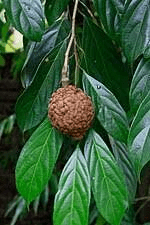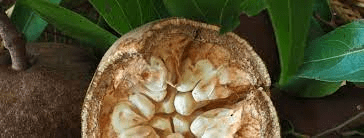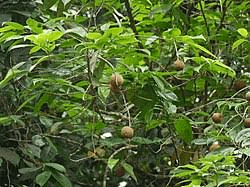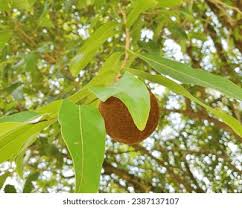Hydnocarpus wightianus, commonly known as Chaulmoogra, is a notable evergreen tree native to the Indian subcontinent. Belonging to the Achariaceae family, this tree holds historical and medicinal significance. The species is primarily found in the Western Ghats, a mountain range along the western edge of the Indian peninsula.
Chaulmoogra is renowned for its distinctive, leathery leaves and small, fragrant flowers. The tree can reach a height of about 15 to 20 meters and features a dense, rounded crown. The leaves are glossy, elliptical, and possess a dark green hue, contributing to the tree’s overall ornamental appeal.
One of the most remarkable aspects of Hydnocarpus wightianus is its seed oil, historically recognized for its therapeutic properties. The oil extracted from Chaulmoogra seeds, known as Chaulmoogra oil, gained prominence in traditional medicine, particularly in Ayurveda. It was extensively used for the treatment of various skin ailments, leprosy in particular, due to its antimicrobial and anti-inflammatory properties.
In the early 20th century, Chaulmoogra oil garnered global attention for its potential in treating leprosy. Although the exact mechanism was not fully understood at the time, it became a crucial component in the treatment of this debilitating disease. However, with the advent of modern medicine and the discovery of more effective treatments, the use of Chaulmoogra oil diminished.
Today, Hydnocarpus wightianus remains a valuable species in the ecological and cultural landscape of the Western Ghats. While its medicinal applications have evolved, the tree continues to contribute to biodiversity, and its historical significance in traditional medicine is a testament to the rich botanical heritage of the Indian subcontinent.
The Botanical Description of Hydnocarpus wightianus
1. Family and Genus: Hydnocarpus wightianus belongs to the family Achariaceae and the genus Hydnocarpus.
2. Morphological Features: This evergreen tree can reach heights of 15 to 20 meters, characterized by a straight trunk and a dense, pyramidal crown. The leaves are alternate, elliptical, and leathery, with a glossy, dark green surface.
3. Flowers: The plant produces small, greenish-yellow flowers with a distinct fragrance. These flowers are arranged in panicles and bloom during specific periods, contributing to the tree’s overall aesthetic appeal.
4. Fruits: The fruits of Hydnocarpus wightianus are oblong capsules containing seeds. These capsules split open when mature, releasing the seeds into the environment.
5. Bark and Wood: The bark is grayish-brown, and the wood is hard and durable. The plant’s timber is occasionally used in local applications.
6. Habitat: Native to the Indian subcontinent, Hydnocarpus wightianus thrives in tropical and subtropical regions. It is well-adapted to a variety of soil types and environmental conditions.
7. Growth Rate: The tree exhibits a moderate growth rate, making it a sustainable resource for various applications.
8. Traditional Uses: Historically, different parts of the plant, including the seeds and oil, have been used in traditional medicine for their therapeutic properties.
9. Conservation Status: While not currently listed as endangered, conservation efforts may be essential due to increasing demands for its medicinal derivatives.
10. Cultivation: Due to its medicinal significance, there is ongoing interest in cultivating Hydnocarpus wightianus for sustainable harvesting.
11. Floral Phenomenon: The flowering and fruiting patterns are intriguing, with specific seasons influencing the plant’s reproductive cycle.
12. Biodiversity Role: In its natural habitat, Hydnocarpus wightianus contributes to the biodiversity of its ecosystem, offering habitat and sustenance for various organisms.
The Geographic Distribution of Hydnocarpus wightianus

1. Native Range: Hydnocarpus wightianus is native to the Indian subcontinent, specifically found in regions such as India, Sri Lanka, and Bangladesh.
2. Climatic Preferences: The plant thrives in tropical and subtropical climates, favoring regions with warm temperatures and high humidity.
3. Altitudinal Range: While it is typically found at lower altitudes, Hydnocarpus wightianus may also occur at higher elevations within its preferred climatic zones.
4. Global Adaptation: Due to its medicinal value, efforts have been made to introduce Hydnocarpus wightianus to regions with similar climatic conditions outside its native range.
5. Ecological Niches: The plant may inhabit a variety of ecological niches, from lowland plains to foothills, showcasing its adaptability.
6. Human Interventions: Cultivation practices and human interventions have played a role in shaping the distribution of Hydnocarpus wightianus beyond its natural range.
7. Conservation Challenges: The demand for its medicinal properties raises concerns about sustainable harvesting and conservation, necessitating responsible management practices.
8. Biotic Associations: Hydnocarpus wightianus engages in various ecological interactions, forming associations with pollinators, seed dispersers, and other organisms within its habitat.
9. Ethnobotanical Significance: The plant holds cultural and traditional significance in local communities, influencing rituals, practices, and traditional healthcare systems.
10. Ex situ Conservation: Efforts to conserve Hydnocarpus wightianus extend to ex situ measures, including botanical gardens and research institutions focused on preserving genetic diversity.
11. Global Impact: The exploration of its distribution beyond its native regions underscores its potential global impact on traditional medicine and pharmaceutical industries.
The Chemical Composition of Hydnocarpus wightianus
1. Chaulmoogric Acid: A key compound, chaulmoogric acid, is known for its medicinal properties and therapeutic applications.
2. Hydnocarpic Acid: This acid contributes to the plant’s antimicrobial and anti-inflammatory attributes.
3. Limonoids: The presence of limonoids adds to the plant’s bioactive profile, influencing its pharmacological potential.
4. Coumarins: Hydnocarpus wightianus contains coumarins, which may contribute to its anticoagulant and anti-inflammatory effects.
5. Triterpenoids: Triterpenoids found in the plant may contribute to its hepatoprotective and antioxidant properties.
6. Essential Oils: The plant’s essential oils contain a spectrum of volatile compounds, each with its unique biological activities.
7. Sterols: Sterols present in Hydnocarpus wightianus may contribute to its cholesterol-lowering and anti-inflammatory effects.
8. Flavonoids: Flavonoids, known for their antioxidant properties, are part of the plant’s chemical composition.
9. Alkaloids: The presence of alkaloids adds to the plant’s diverse chemical profile, influencing its potential pharmacological applications.
10. Phenolic Compounds: Phenolic compounds contribute to the antioxidant capacity of Hydnocarpus wightianus, playing a role in its overall medicinal properties.
11. Glycosides: Glycosides found in the plant may have cardioprotective and anti-inflammatory effects, adding to its therapeutic potential.
12. Lignans: The presence of lignans in Hydnocarpus wightianus may contribute to its anti-cancer and anti-inflammatory properties.
13. Biological Activities: The chemical constituents collectively exhibit various biological activities, including antibacterial, antifungal, anti-inflammatory, and antioxidant effects.
14. Medicinal Applications: Understanding the chemical composition provides insights into the plant’s traditional and modern medicinal applications, guiding further research and development.
15. Extraction Methods: Different extraction methods are employed to isolate specific compounds, ensuring the preservation of their medicinal properties.
16. Synergistic Effects: The synergistic effects of various compounds in Hydnocarpus wightianus contribute to its overall therapeutic efficacy, making it a valuable resource in traditional and modern medicine.
17. Quality Control: Establishing quality control measures is crucial in ensuring the consistency and potency of Hydnocarpus wightianus-derived products for medicinal use.
18. Research Opportunities: The exploration of the plant’s chemical composition opens avenues for further research, uncovering new bioactive compounds and their potential applications.
Read Also: Groundhogs (woodchucks): Description, Damages Caused, Control and Preventive Measures
The Medicinal Health Benefits Of Hydnocarpus wightianus (Chaulmoogra)

1. Anti-inflammatory Effects: Compounds present in Hydnocarpus wightianus exhibit potent anti-inflammatory properties, making it beneficial for conditions such as arthritis, rheumatism, and inflammatory skin disorders.
2. Antimicrobial Activity: The plant demonstrates antimicrobial activity against a wide range of pathogens, including bacteria, fungi, and viruses, making it useful in the treatment of various infectious diseases.
3. Skin Disorders: Hydnocarpus wightianus oil has been traditionally used to treat skin disorders such as eczema, psoriasis, and dermatitis due to its soothing and healing properties.
4. Wound Healing: Its antimicrobial and anti-inflammatory properties contribute to faster wound healing, making it effective in treating cuts, burns, and other minor injuries.
5. Respiratory Health: The plant is beneficial for respiratory health, helping to alleviate symptoms of cough, cold, asthma, and bronchitis.
6. Analgesic Properties: Hydnocarpus wightianus exhibits analgesic properties, providing relief from pain associated with conditions like arthritis, muscle aches, and headaches.
7. Antioxidant Action: Its antioxidant compounds help neutralize free radicals, reducing oxidative stress and lowering the risk of chronic diseases such as cancer, cardiovascular disorders, and neurodegenerative conditions.
8. Immune Enhancement: Regular consumption of Hydnocarpus wightianus may boost immune function, enhancing the body’s ability to fight off infections and diseases.
9. Digestive Support: The plant aids in digestion and gastrointestinal health, relieving symptoms of indigestion, bloating, and stomach discomfort.
10. Cardiovascular Protection: Some compounds in Hydnocarpus wightianus have cardioprotective effects, promoting heart health and reducing the risk of cardiovascular diseases.
11. Liver Health: It supports liver function and detoxification processes, helping to maintain optimal liver health and preventing liver disorders.
12. Mental Well-being: The plant may have positive effects on mental well-being, promoting relaxation, reducing stress, and improving mood.
13. Hormonal Balance: Hydnocarpus wightianus may help balance hormones in the body, benefiting reproductive health and overall hormonal equilibrium.
14. Anti-diabetic Properties: Some research suggests that certain compounds in the plant may have anti-diabetic effects, helping to regulate blood sugar levels and manage diabetes.
15. Anti-cancer Potential: Preliminary studies indicate that Hydnocarpus wightianus may possess anti-cancer properties, inhibiting the growth and spread of cancer cells in various types of cancer.
16. Anti-allergic Activity: The plant’s anti-allergic properties make it useful in alleviating symptoms of allergic reactions, such as itching, swelling, and redness.
17. Antispasmodic Action: Hydnocarpus wightianus exhibits antispasmodic effects, relieving muscle spasms and cramps associated with conditions like menstrual cramps and gastrointestinal disorders.
18. Hair and Scalp Health: Topical application of Hydnocarpus wightianus oil may improve hair and scalp health, reducing dandruff, promoting hair growth, and nourishing the scalp.
The Methods of Usage to Achieve the Provided Health Benefits Of Hydnocarpus wightianus (Chaulmoogra)
1. Topical Application: Apply Hydnocarpus wightianus oil or ointment directly to the skin to treat various skin disorders, wounds, and injuries.
2. Massage Therapy: Incorporate Hydnocarpus wightianus oil into massage therapy sessions to alleviate muscle aches, pains, and tension, promoting relaxation and well-being.
3. Inhalation: Inhale steam infused with Hydnocarpus wightianus oil to relieve respiratory congestion, cough, and sinusitis, supporting clear breathing and respiratory health.
4. Aromatherapy: Diffuse Hydnocarpus wightianus essential oil in your home or workspace to create a calming atmosphere, reduce stress, and uplift mood.
5. Bath Soak: Add a few drops of Hydnocarpus wightianus oil to your bathwater for a soothing and therapeutic experience, promoting relaxation and relieving muscle tension.
6. Compress: Prepare a warm or cold compress infused with Hydnocarpus wightianus oil to alleviate pain, inflammation, and swelling associated with injuries or inflammatory conditions.
7. Hair Care: Massage Hydnocarpus wightianus oil into the scalp to nourish hair follicles, promote hair growth, and improve overall hair and scalp health.
8. Oral Consumption: Consume Hydnocarpus wightianus oil or extract orally, following recommended dosage guidelines, to benefit from its internal therapeutic effects on various health conditions.
9. Dietary Supplement: Incorporate Hydnocarpus wightianus oil or extract into your daily diet as a dietary supplement, adding it to foods, beverages, or capsules for systemic health benefits.
10. Herbal Tea: Brew Hydnocarpus wightianus leaves or flowers into a herbal tea to enjoy its soothing and healing properties, promoting digestive health and overall well-being.
11. Skin Care: Use Hydnocarpus wightianus oil-based skincare products such as creams, lotions, or balms to moisturize, nourish, and protect the skin, combating dryness, irritation, and aging.
12. Traditional Formulations: Explore traditional medicinal formulations containing Hydnocarpus wightianus in combination with other herbs and ingredients to address specific health concerns or conditions effectively.
The Side Effects Of Using Hydnocarpus wightianus Medicinal Plant
1. Skin Irritation: Topical application of Hydnocarpus wightianus oil may cause skin irritation, redness, itching, or rash in sensitive individuals.
2. Allergic Reactions: Some individuals may experience allergic reactions to Hydnocarpus wightianus oil or its components, leading to symptoms such as hives, swelling, or difficulty breathing.
3. Photosensitivity: Exposure to sunlight after applying Hydnocarpus wightianus oil topically may increase the risk of sunburn or skin sensitivity reactions.
4. Gastrointestinal Upset: Oral consumption of Hydnocarpus wightianus oil or extract may cause gastrointestinal discomfort, such as nausea, vomiting, or diarrhea, in some individuals.
5. Respiratory Irritation: Inhalation of concentrated Hydnocarpus wightianus oil vapors may irritate the respiratory tract, triggering coughing, wheezing, or throat irritation.
6. Hormonal Effects: Certain compounds in Hydnocarpus wightianus may have hormonal effects, potentially affecting hormone levels or reproductive health in some individuals.
7. Blood Pressure Changes: Hydnocarpus wightianus oil may influence blood pressure, leading to fluctuations in blood pressure levels, especially in individuals with hypertension or cardiovascular conditions.
8. Liver Toxicity: Excessive consumption of Hydnocarpus wightianus oil or extract may pose a risk of liver toxicity or damage, particularly in sensitive individuals or those with pre-existing liver conditions.
9. Drug Interactions: Hydnocarpus wightianus may interact with certain medications, affecting their efficacy or increasing the risk of adverse reactions, especially in individuals taking blood thinners, anticoagulants, or immunosuppressants.
10. Pregnancy and Lactation: Pregnant or breastfeeding women should exercise caution when using Hydnocarpus wightianus products, as their safety during these periods has not been adequately studied.
11. Children and Infants: The use of Hydnocarpus wightianus products in children or infants should be supervised by healthcare professionals, as their safety and efficacy in this population have not been well-established.
12. Sensitivity Testing: Before using Hydnocarpus wightianus products, perform a patch test to check for any allergic reactions or skin sensitivities, especially if you have a history of allergies or sensitive skin.
13. Dosage Considerations: Adhere to recommended dosage guidelines when using Hydnocarpus wightianus products to minimize the risk of side effects and ensure safe and effective use.
14. Consultation with Healthcare Provider: If you experience any adverse reactions or side effects while using Hydnocarpus wightianus products, discontinue use and consult a healthcare provider for appropriate guidance and management.
Read Also: Groundhogs (woodchucks): Description, Damages Caused, Control and Preventive Measures
The Scientific Research and Studies of Hydnocarpus wightianus

1. Antimicrobial Activity: Studies have demonstrated the antimicrobial activity of Hydnocarpus wightianus against various pathogens, including bacteria, fungi, and viruses, highlighting its potential as a natural antimicrobial agent.
2. Anti-inflammatory Effects: Research indicates that Hydnocarpus wightianus exhibits significant anti-inflammatory effects, inhibiting inflammatory mediators and pathways involved in inflammatory processes.
3. Wound Healing Properties: Experimental studies have shown that Hydnocarpus wightianus accelerates wound healing by promoting collagen synthesis, angiogenesis, and epithelialization, making it beneficial for the management of wounds and injuries.
4. Antioxidant Capacity: The plant possesses potent antioxidant properties, scavenging free radicals and reducing oxidative stress, which may help prevent oxidative damage and associated diseases.
5. Anti-cancer Potential: Preliminary investigations suggest that certain compounds in Hydnocarpus wightianus may have anti-cancer effects, inhibiting the growth and proliferation of cancer cells in vitro and in animal models.
6. Safety and Toxicity Studies: Toxicological evaluations have been conducted to assess the safety profile of Hydnocarpus wightianus extracts and derivatives, providing valuable data on their acute and chronic toxicity, genotoxicity, and mutagenicity.
The Safety Precautions and Recommendations In Using Hydnocarpus wightianus Medicinal Plant
1. Quality Assurance: Purchase Hydnocarpus wightianus products from reputable suppliers to ensure quality, purity, and authenticity.
2. Allergy Testing: Perform a patch test before using Hydnocarpus wightianus products topically to check for any allergic reactions or skin sensitivities.
3. Dilution: Dilute concentrated Hydnocarpus wightianus oil with a carrier oil before topical application to reduce the risk of skin irritation or sensitization.
4. Dosage Guidance: Adhere to recommended dosage guidelines when using Hydnocarpus wightianus products internally or externally to avoid adverse reactions or toxicity.
5. Pregnancy and Lactation: Pregnant or breastfeeding women should consult healthcare professionals before using Hydnocarpus wightianus products due to limited safety data during these periods.
6. Children and Infants: Use caution when administering Hydnocarpus wightianus products to children or infants, and consult healthcare providers for appropriate dosage and supervision.
7. Drug Interactions: Be aware of potential drug interactions with Hydnocarpus wightianus products, especially if you are taking medications, and consult healthcare providers for guidance.
8. Sun Protection: Avoid sun exposure or use sun protection measures after applying Hydnocarpus wightianus oil topically to prevent photosensitivity reactions.
9. Storage: Store Hydnocarpus wightianus products in a cool, dry place away from direct sunlight to maintain their potency and stability.
10. Discontinue Use: Discontinue use of Hydnocarpus wightianus products if you experience any adverse reactions or side effects and seek medical attention if necessary.
11. Consultation with Healthcare Provider: Consult healthcare providers before using Hydnocarpus wightianus products, especially if you have pre-existing medical conditions, allergies, or are taking medications.
12. Supervision: Use Hydnocarpus wightianus products under the supervision of qualified healthcare professionals, particularly for therapeutic purposes or in sensitive populations.
13. Adverse Effects Reporting: Report any adverse effects or reactions associated with Hydnocarpus wightianus products to healthcare authorities or regulatory agencies for evaluation and monitoring.
14. Education and Awareness: Educate yourself about the potential benefits, risks, and proper usage of Hydnocarpus wightianus products to make informed decisions regarding your health and well-being.
FAQs About Hydnocarpus wightianus Medicinal Plant
1. Is Hydnocarpus wightianus safe for topical use?
Yes, Hydnocarpus wightianus is generally safe for topical use when properly diluted and applied according to recommended guidelines. However, individuals with sensitive skin or allergies should perform a patch test before use.
2. Can Hydnocarpus wightianus be consumed orally?
Yes, Hydnocarpus wightianus oil or extract can be consumed orally for various health benefits. However, it’s essential to follow recommended dosage guidelines and consult healthcare providers, especially if you have pre-existing medical conditions or are taking medications.
3. What are the potential side effects of using Hydnocarpus wightianus?
Potential side effects of using Hydnocarpus wightianus may include skin irritation, allergic reactions, gastrointestinal upset, and hormonal effects. It’s crucial to be aware of these side effects and seek medical attention if necessary.
4. Can Hydnocarpus wightianus be used during pregnancy and lactation?
Pregnant or breastfeeding women should exercise caution when using Hydnocarpus wightianus products, as their safety during these periods has not been adequately studied. Consult healthcare providers before use.
5. Are there any drug interactions with Hydnocarpus wightianus?
Hydnocarpus wightianus may interact with certain medications, including blood thinners, anticoagulants, and immunosuppressants. Consult healthcare providers if you are taking medications to avoid potential interactions.
6. How should Hydnocarpus wightianus products be stored?
Hydnocarpus wightianus products should be stored in a cool, dry place away from direct sunlight to maintain their potency and stability. Follow storage instructions provided by manufacturers.
7. Is Hydnocarpus wightianus suitable for children?
Use caution when administering Hydnocarpus wightianus products to children, and consult healthcare providers for appropriate dosage and supervision, especially for therapeutic purposes.
8. Can Hydnocarpus wightianus be used for pets?
While Hydnocarpus wightianus may offer some benefits for pets, it’s essential to consult veterinarians for guidance on dosage, administration, and safety, as pets may react differently to botanical products.
9. How long does it take to see results with Hydnocarpus wightianus products?
The time to see results with Hydnocarpus wightianus products may vary depending on individual factors, health conditions, and dosage. Consistent use and adherence to recommended guidelines are essential for optimal results.
10. Where can I find Hydnocarpus wightianus products?
Hydnocarpus wightianus products, including oils, extracts, and supplements, may be available at herbal stores, pharmacies, online retailers, and healthcare providers’ offices. Ensure to choose reputable sources for quality and authenticity.
11. Can Hydnocarpus wightianus be used as a natural remedy for specific health conditions?
Yes, Hydnocarpus wightianus is used as a natural remedy for various health conditions, including skin disorders, respiratory problems, inflammation, pain, and more. Consult healthcare providers for personalized recommendations.
12. How can I learn more about the benefits and uses of Hydnocarpus wightianus?
You can learn more about the benefits and uses of Hydnocarpus wightianus by consulting reputable sources, including healthcare professionals, herbalists, scientific journals, books, and online resources. Stay informed and make educated decisions about your health and well-being.

